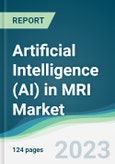MRI or magnetic resonance imaging is a type of non-invasive medical imaging solution, which helps in detecting various types of internal structures. In MRI technology, the integration of artificial intelligence helps in enhancing the maximum potential of the MRI technology. The AI in the MRI helps in enhancing the efficiencies of the imaging solution, and it also increases the potential of detecting diseases more accurately.
The increasing technological advancements in the healthcare sector are expected to boost the demand for AI technology in the MRI market. The AI technology witnessed massive growth, majorly with the increasing governmental initiatives across multiple nations to integrate the technology in the healthcare sector.
Artificial Intelligence (AI) in the MRI Market Drivers
The growing prevalence of cancer is driving the market growth globally.The rising global cases of cancers and other forms of chronic diseases are also expected to propel the growth of AI in the MRI market, during the forecasted timeline. For instance, according to the American Cancer Society, Inc. in its 2023 Cancer report stated that in the USA, the total estimated new cases of cancer were recorded at 1.958 million, with about 1.010 million new cases recorded in males, and 0.948 million cases recorded in females.
As per the American Heart Association, Inc, Cardiovascular mortality in the United States has risen to 931,578 in 2024 from 928,741 in 2023. It breaks down into deaths from coronary heart disease (40.3%), stroke (17.5%), other minor CVD causes (17.1%), high blood pressure (13.4%), heart failure (9.1%), and artery diseases (2.6%).
Another growing trend is patient comfort and access to care as improving scan time with less discomfort and personalized care as other driving factors for AI based MRI software. Demands for client-centric software systems that improve MRI scan precision, efficiency, and accessibility propel this trend.
MRI Software Using AI Technology is poised to grow concerning innovations in point-of-care imaging, workflow optimization, and improving images with more AI-powered denoising techniques for diverse MRI sequences, as well as the advent of even smaller and easily portable AI-powered imaging in the future.
Hyperfine, Inc. announced the introduction of the eighth-generation software of the Swoop® system, approved by CE and UKCA in January 2024. The software includes improved image quality and convenience and is being launched at selected sites. The DWI AI denoising feature gained FDA clearance in October 2023. This software extends real-time assistance for more accurate loading and patient positioning, along with a more streamlined image upload procedure. Swoop® is revolutionizing the neuroimaging workflow by bringing brain imaging to the point of the patient's bedside rather than expensive, statically deployed MRI technology.
The growing use of MRI scans generates a significant amount of data, which can be challenging for human radiologists to efficiently analyze. AI algorithms can quickly process and provide valuable insights.
Artificial Intelligence (AI) in the MRI Market Geographical Outlook:
North America will continue to hold a remarkable share of the market during the forecast period.Artificial Intelligence has established a framework of exploring new opportunities of the modern technology applicability in varied healthcare fields, that would optime the diagnosis and treatment process. The United States stands at the forefront of adopting such latest innovations. According to the research study issued by Oxford Scholars, in which nearly 5,920 hospitals across 50 US states were surveyed. It was noted that 18.70% or 1,107 hospitals adopted some form of Artificial Intelligence by 2022, and hospitals in major states namely New Jersey held the highest adoption rate of 48.94%.
The rise in the demand for effective treatment and precise diagnosis has garnered a wide customer base for advanced technologies which has positively impacted the scope of AI usage in MRI applications. This growing prevalence of chronic disease especially cardiac-related is posing a challenge for US healthcare professionals to leverage a proprietary technology that would target the breakthroughs in treatment and offer high-quality diagnostic MRI. Hence major companies are investing in strategic partnerships and research collaboration to meet this demand. For instance, on 3rd December 2024, Mayo Clinic formed a research collaboration with Philips that aimed to optimize the latter's technical with Mayo's healthcare expertise which will harness the Artificial Intelligence usage in advanced MRI for cardiac applications.
Reasons for buying this report:
- Insightful Analysis: Gain detailed market insights covering major as well as emerging geographical regions, focusing on customer segments, government policies and socio-economic factors, consumer preferences, industry verticals, other sub-segments.
- Competitive Landscape: Understand the strategic maneuvers employed by key players globally to understand possible market penetration with the correct strategy.
- Market Drivers & Future Trends: Explore the dynamic factors and pivotal market trends and how they will shape up future market developments.
- Actionable Recommendations: Utilize the insights to exercise strategic decision to uncover new business streams and revenues in a dynamic environment.
- Caters to a Wide Audience: Beneficial and cost-effective for startups, research institutions, consultants, SMEs, and large enterprises.
What do businesses use our reports for?
Industry and Market Insights, Opportunity Assessment, Product Demand Forecasting, Market Entry Strategy, Geographical Expansion, Capital Investment Decisions, Regulatory Framework & Implications, New Product Development, Competitive IntelligenceReport Coverage:
- Historical data & forecasts from 2022 to 2030
- Growth Opportunities, Challenges, Supply Chain Outlook, Regulatory Framework, Customer Behaviour, and Trend Analysis
- Competitive Positioning, Strategies, and Market Share Analysis
- Revenue Growth and Forecast Assessment of segments and regions including countries
Company Profiling (Strategies, Products, Financial Information, and Key Developments among others
AI in MRI Market is segmented and analyzed as follows:
By Solution
- Software
- Services
By End-User
- Hospitals
- Clinics
- Diagnostic Centers
By Geography
- North America
- South America
- Europe
- Middle East and Africa
- Asia-Pacific
Table of Contents
Companies Mentioned
- Siemens Healthineers AG
- GE HealthCare
- IBM
- Philips Healthcare
- NVIDIA Corporation
- Oxipit.ai
- Quibim
- Intel
- AWS
- Google Cloud
- Aikenist Technologies Pvt. Ltd.
- CARPL.ai
- Subtle Medical, Inc.








